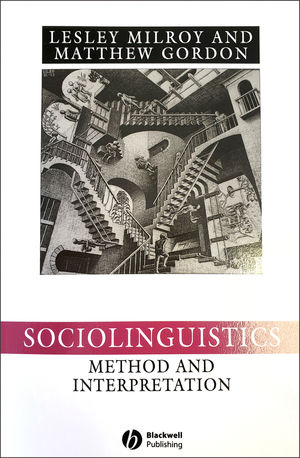Sociolinguistics: Method and Interpretation, 2nd EditionISBN: 978-0-631-22225-5
Paperback
288 pages
January 2003, Wiley-Blackwell
 This is a Print-on-Demand title. It will be printed specifically to fill your order. Please allow an additional 10-15 days delivery time. The book is not returnable.
|
||||||
1. Sociolinguistics: Models and Methods:.
Data and Theory.
Earlier Approaches to Linguistic Description.
The American Descriptivists.
Traditional Dialectology.
Adaptations of the Traditional Model.
Between Paradigms: Early Urban Studies.
Bridging Paradigms: Adaptations of Traditional Dialectology.
2. Locating and Selecting Subjects:.
Introductory.
Representativeness.
Some General Principles.
Defining the Sampling Universe.
Stratification and Sample Size.
Quota and Judgment Sampling.
Research Objectives and Sampling: Some Examples.
Sampling and Age.
Sampling and Social Class.
Concluding Remarks.
3. Data Collection:.
General Issues.
Survey Approaches to Data Collection.
Written Questionnaires.
Fieldworker-Administered Surveys.
Rapid and Anonymous Surveys.
Sociolinguistic Interviews.
The Structure and Design of the Interview.
Interviews as Speech Events.
Interview Strategies for Eliciting Casual Speech.
Participant Observation.
Balancing Fieldwork Strategies: The Belfast Project.
The Community Studies.
The Belfast Doorstep Survey.
The Rural Hinterland Study.
Research Ethics.
Informed Consent.
Preservation of Anonymity and Access to Recordings.
Surreptitious Recording.
The Researcher's Responsibility.
Conclusion.
4. Language Variation and the social World: Issues in Analysis and Interpretation:.
Introductory.
Social Categories and Theories of Change.
Social Class and Sociolinguistic Research.
Models of Social Class.
Linguistic Markets.
Interpreting Correlations between Language and Social Class.
Sex and Gender.
Introduction.
Social Class and Gender.
Gender and Language Variation: Some Further Issues.
Ethnicity and Race.
Introduction.
Language, Race and Ethnicity in the United States.
Language and Ethnicity in Northern Ireland.
Concluding Remarks.
5. Social Relationships and Social Practices:.
Introductory.
The Concept of Social Network.
Social Network and Community of Practice.
Social Networks and Language Variation.
Network Structure and Language Shift in Bilingual Communities.
Weak Network Ties and Theories of Language Change.
Dialect Leveling.
The Sociolinguistics of Mobility: Place as a Cultural Concept.
Concluding Remarks.
6. Investigating Phonological Variation:.
Introductory.
Identifying and Selecting Variables.
Types of Phonological Variables.
Choosing and Specifying Variables.
Pilot Studies.
Measuring Variation.
Auditory Techniques.
Instrumental Techniques.
An Evaluation of Measurement Techniques.
The Linguistic Analysis of Phonological Variables.
Defining the Range of Variation.
Conditioning Factors.
The Relationships among Variants: Issues of Interpretation.
Comments about Quantification.
Counting Matters.
How Many Tokens are Needed?.
Use of Statistical Analysis.
7. Beyond Phonology: Analyzing and Interpreting Higher Level Variation:.
Introductory.
Data Collection Issues.
Grammatical Variables and Historical Linguistics.
Syntactic Analysis and the Sociolinguistic Variable.
Some Early Work.
The Principle of Accountability and the Envelope of Variation.
Semantic Equivalence and the Discourse Context.
Variationist Analysis and Syntactic Theory.
Concluding Remarks.
8. Style-shifting and Code-Switching:.
Introductory.
Style as a Response to Situation.
Stylistic Variation as a Function of Attention Paid to Speech.
Style as Audience Design.
Style as Initiative and Strategic.
Code-switching.
Introductory.
“Allocational” and “Interactional” Paradigms.
Language Choice and Code-switching: Three Case Studies.
Bilingual Conversations.
Concluding Remarks.
9. Epilogue.
References.
Index.



